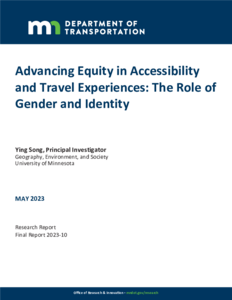Centering the Margins: The Transportation Experience of Underserved Communities
Creator
Date Created
2023-08
Report Number
2023-32
Description
Advancing Equity in Accessibility and Travel Experiences: The Role of Gender and Identity
Date Created
2023-05
Report Number
2023-10
Description
Understanding post-COVID safety concerns toward the use of transit and shared mobility in Greater Minnesota
Date Created
2023-04
Report Number
2023-16
Description
The Health and Transportation Nexus: A Conceptual Framework for Collaborative and Equitable Planning
The ABC Parking Ramps in Minneapolis: A Unique Past; A Visionary Future
Creator
Date Created
2019
Report Number
2019-13
Description
The Transportation Futures Project: Planning for Technology Change
Date Created
2016
Report Number
2016-02
Description
Exploring Strategies for Promoting Modal Shifts to Transitways
Date Created
2015
Report Number
2015-49
Description
Travel Behavior Over Time
Creator
Date Created
2015
Report Number
2015-23
Description









